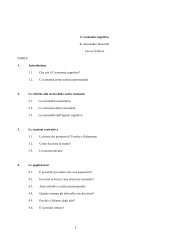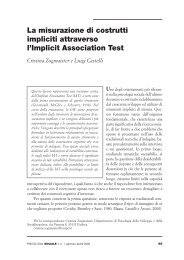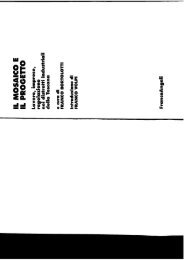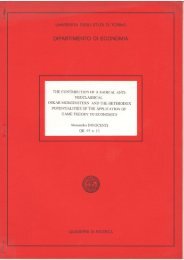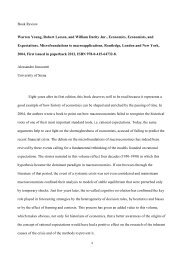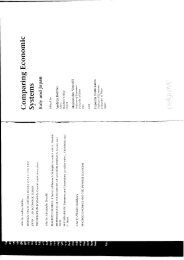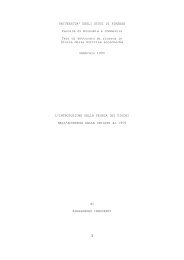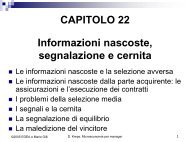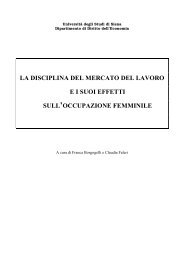Abstracts Book - LabSi
Abstracts Book - LabSi
Abstracts Book - LabSi
You also want an ePaper? Increase the reach of your titles
YUMPU automatically turns print PDFs into web optimized ePapers that Google loves.
Hans-Ulrich Stark,*° Dirk Helbing,* Martin Schönhof,* and Janusz A. Hoyst** (*Dresden<br />
University of Technology, °ETH Zurich, **Warsaw University of Technology)<br />
“Alternating cooperation strategies in a Route Choice game: Theory, experiments, and<br />
evidence of learning scenarios”<br />
In this paper, we present experimental investigations on a day-to-day route choice scenario. Here,<br />
the equilibrium outcome is, according to real traffic observations, fair (equal for all users) but<br />
induces an inefficient usage of network capacity. Optimal usage would be characterized by some<br />
users winning and some losing in comparison to the equilibrium state. Coherent alternating<br />
cooperation strategies can be a suitable solution but they require innovation and group coordination<br />
in addition to cooperativeness. In these points, our work differs considerably from other<br />
contributions observing the emergence of cooperation in social dilemmas. By classifying the twoperson<br />
variant of our experiments among the symmetrical 2x2 games we show the situation of the<br />
Route Choice Game not to not addressed by the literature so far. Although the equilibrium outcome<br />
in this setup is “strongly stable", in our experiments we find eminent empirical evidence of<br />
alternating cooperation and, thereby, observed persistent utilization of the system optimum that is<br />
not profitable for all individuals. The transition to this optimal configuration can be well described<br />
by quantitative considerations that are presented in the paper. Furthermore, the straight success of a<br />
learning scenario indicates that the collective innovation of alternating strategies may be the most<br />
critical challenge to the individuals instead of just learning to be cooperative. Presumably, this also<br />
holds for other social dilemma situations.<br />
Michele Bernasconi* and Matteo Galizzi** (*Università dell’Insubria, **Università di Brescia)<br />
“Coordination in Networks Formation: Experimental Evidence on Learning and Salience”<br />
We present experiments on repeated non-cooperative network formation games, based on Bala and<br />
Goyal (2000). We treat the one-way and the two-ways flow models, each for high and low link<br />
costs. The models show both multiple equilibria and coordination problems. We conduct<br />
experiments under various conditions which control for salient labeling and learning dynamics.<br />
Contrary to previous experiments, we find that coordination on non-empty Strict Nash equilibria is<br />
not an easy task for subjects to achieve, even in the mono-directional model where the Strict Nash<br />
equilibria is a wheel. We find that salience significantly helps coordination, but only when subjects<br />
are pre-instructed to think at the wheel network as a reasonable way to play the networking game.<br />
Evidence on learning behavior provides support for subjects choosing strategies consistent with<br />
various learning rules, which include as the main ones Reinforcement and Fictitious Play.<br />
Antoine Terracol*° and Jonathan Vaksmann° (*Université Lille 3, °Université Paris 1 - Panthéon<br />
Sorbonne, CNRS)<br />
“Dumbing down rational players: adaptive learning and teaching in an experimental game”<br />
This paper uses experimental data to examine the existence of a teaching strategy among adaptive<br />
players. If players realize their own action modify their opponents’ beliefs and actions, they might<br />
play certain actions in such a way; and forego immediate payoffs if the expected payoff gain from<br />
such a teaching strategy is high enough. Our results support the existence of a teaching strategy in<br />
three ways: They first show that players update their beliefs in order to take account of the reaction<br />
of their opponents to their own action. Second, within a logit model, they suggest that the future<br />
expected payoff that could arise from a teaching strategy has a significant impact on action<br />
probabilities. Finally, the attraction for the ‘teaching action’, i.e. the action associated with the<br />
24



